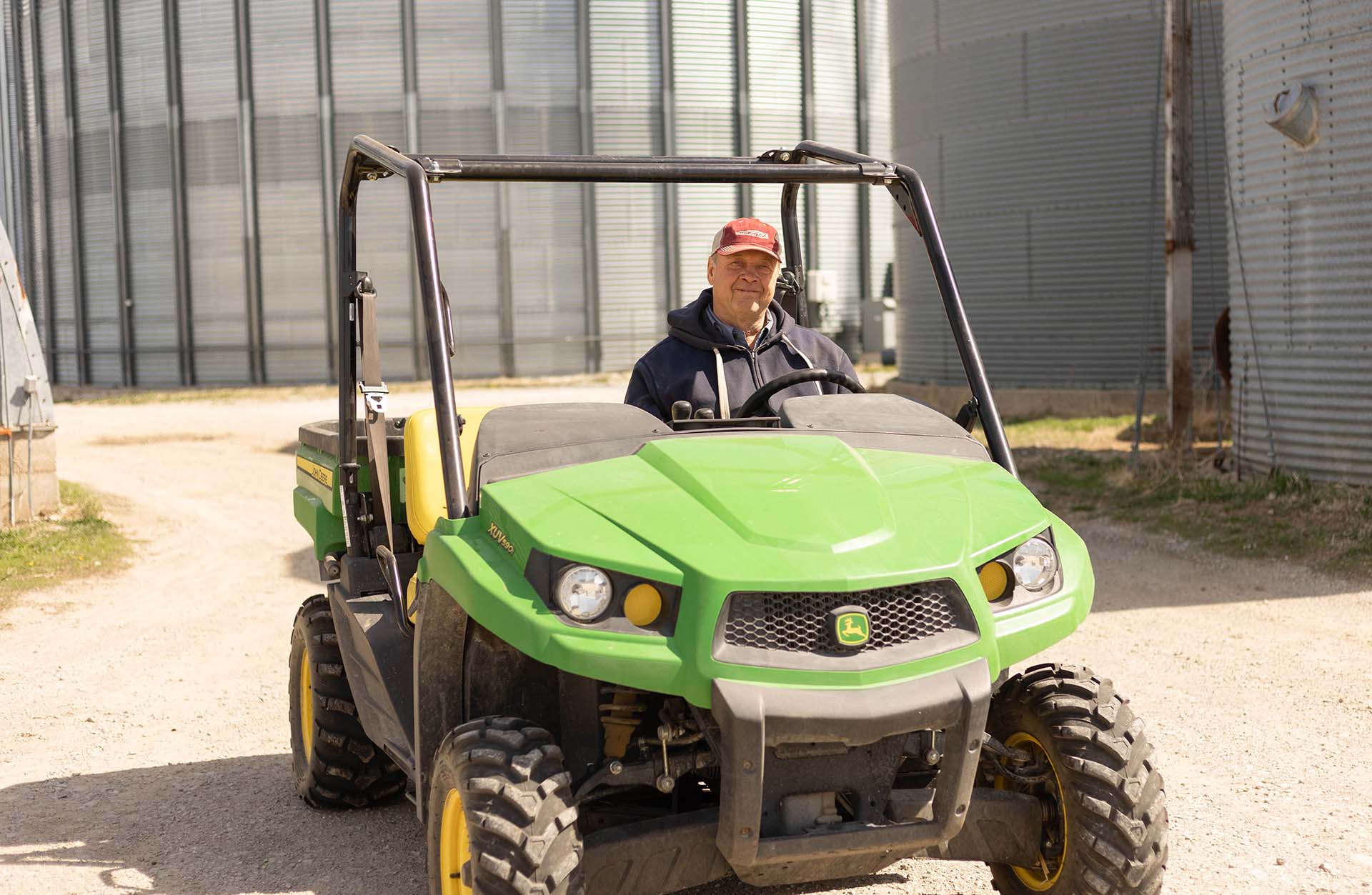
Steve McGrew driving an off-road vehicle on his farm. (Photo: Iowa Soybean Association / Joclyn Bushman)
Staying safe with off-road vehicles this fall
September 26, 2024
When he was younger, Ben Veren remembers climbing into the combine or on the tractor and guiding his equipment through the hundreds of acres of soybeans and corn his family farmed.
“I do miss those days,” he says. “Especially during the harvest with the fall temperatures and you just focus on the quiet in the tractor cab and you are alone with your thoughts.”
But Veren also recalls the potential dangers and pitfalls of harvest season. And as a chief deputy with the Marshall County Sheriff’s Office, he has witnessed his fair share of farm-related accidents and fatalities.
But safety concerns are not limited to tractors and combines, Veren says.
Safety first
Off-road Vehicles (ORV), which include All-Terrain Vehicles (ATV), Utility Task Vehicles (UTV), and Recreational Off-Highway Vehicles (ROV), are as ubiquitous as combines, tractors and pickup trucks. However, these vehicles have been associated with higher rates of injuries and fatalities, in both work and recreational use, and especially during harvest.
Veren says he has seen a noticeable increase in ATV and UTV crashes in central Iowa, as well as other rural areas throughout Iowa in recent years.
“In most situations, it’s just a case of being in a hurry,” he says. “These injuries are very preventable. Often times, farmers are doing chores and shorts jaunts to their fields and they overlook the speed and other protections they need to take.”
With an uptick in crashes, according to some preliminary data Veren has seen, too many injuries are occurring with these ORVs.
“I think there’s a false sense of security on the part of some farmers,” he says. “They forget that there are no airbags or crash crumple zones like you have in your car or pickup truck.”
The veteran law enforcement officer says ATV and UTV manufacturers recommend that drivers and passengers wear helmets and secure their seatbelts.
“We’re seeing statewide these side-by-side vehicle accidents are more severe because occupants were not wearing either a helmet or their seatbelts,” Veren says.
And he knows seatbelt usage is not what it should be in rural Iowa because of the availability of seatbelt safety switch bypass equipment that anyone can find on Amazon or from other retailers.
“Complacency is the big issue,” Veren says. “That farmer drives his ATV or utility vehicle dozens of times throughout the week without that seatbelt or helmet. But without those, they are definitely at a disadvantage.”
And given the wet spring and summer, the shoulders of many rural roads have either washed away or eroded to the point where too much speed or not paying attention might roll an ORV into the ditch.
“There’s a lot of potential for crashes to happen, so drivers need to be cognizant of what’s going on,” Veren says.
Safety tips
According to Iowa’s Center for Agriculture Safety and Health (I-CASH), ORVs are prohibited on most roadways; however, there are legal exceptions for occupational use, including use in agriculture.
Iowa Code states that ORVs can be operated on Iowa public roadways for agricultural purposes with the following limitations:
- Operators must have a valid driver’s license.
- Speed must not exceed 35 mph.
- Operation must occur between sunrise and sunset.
I-CASH notes that while the Iowa occupational exemption is important for farmers traveling between fields, ORVs are not designed for roadway use. As a result, using them on roads can be unsafe and operators should take extra precautions:
- Be as visible as possible by purchasing a brightly colored vehicle and wearing bright clothing.
- Display a fluorescent orange flag on ATVs at least five feet above the ground.
- ALWAYS wear a helmet. Among ATV injuries in Iowa, those wearing a helmet were 80% less likely to have suffered a head injury.
- Use seatbelts in ROVs and do not have additional riders on ATVs.
- If the ROV has the ability to unlock the rear differential, do so before traveling on roadways.
Veren also says ORV operators should use their turn signals, especially if they’re going to make a left turn into a field, so that other drivers are aware of what’s ahead.
“And always keep a check over your shoulder to see who might be nearby,” he says.
Staying connected
Farmers often go out alone to survey their fields or pastureland, sometimes several miles away from the farmhouse.
Regardless of the season, Veren says it’s important that producers share their whereabouts with family and friends before venturing out.
“With rural accidents and in remote areas, those injured or incapacitated are often not discovered for a long time,” he says. “In general, making sure someone knows where you are could be a lifesaver.”
While many farmers carry a cell phone with them and are able to call for help or assistance, first responders sometimes have difficulty finding the caller.
Although technology is increasingly better than in years past, Veren says there are still many pockets within rural areas that have a tough time connecting to 911 operators.
“It’s important that your cell phone is charged and that you have it with you in case of an emergency,” he says. “If 911 operators are struggling to connect with someone who may be injured or stranded, texting conversations or video chat might also be of use.
“Just let someone know where you’re going so that if you don’t hear from you, they know where to start looking.”
Back